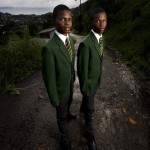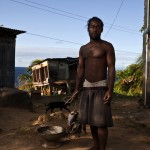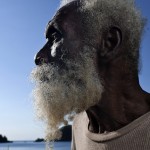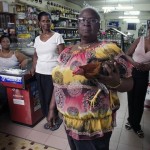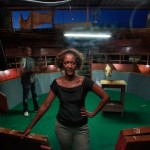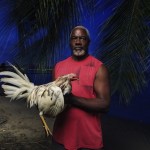Robert Charlotte
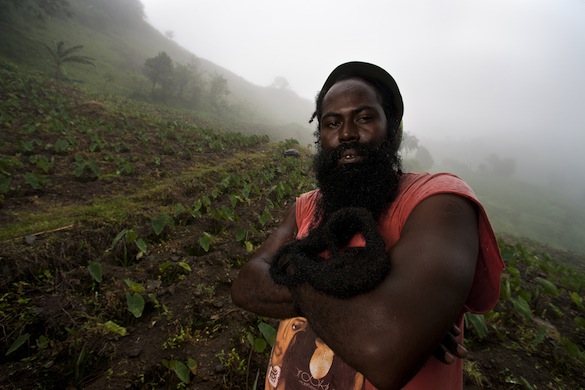
C’est à Saint-Vincent, caillou de quelque trois cent quarante-six kilomètres carrés des Petites Antilles, que commence ce voyage.
L’histoire raconte que suite au naufrage, en 1635, de navires battant pavillon espagnol chargés d’or et d’esclaves, les Caliponan, métisses amérindiens qui vivaient sur l’île, se mêlèrent aux esclaves en provenance d’Afrique noire, donnant ainsi naissance au peuple Garifuna. Il est dit que ce dernier résista à la colonisation française tout en adoptant quelques traits de sa culture, puis s’y allia pour contrer les invasions britanniques mais que l’échec de cette alliance, pourtant lestée des idéaux révolutionnaires importés de l’Hexagone, mena à la déportation, en 1797, d’une partie de la population vers les côtes du Honduras, du Guatemala et du Belize. La diaspora de ce métissage afro-caribéen mêlé d’éléments de cultures européennes s’étend aujourd’hui du Honduras, où vivent environ cent mille Garinagu, aux États-Unis où en sont établis presque quatre-vingt-dix mille. Si l’histoire, l’argumentée, la précise, reste encore à écrire, c’est « cette non-influence coloniale dans le bassin caribéen, ce mélange de cultures né cette fois d’une volonté, celle d’être libre et de le demeurer » qui fascine, selon ses termes, le photographe Robert Charlotte. Il est ainsi parti à la rencontre des Garinagu de Saint-Vincent, enquêtant pour cela aux côtés de l’anthropologue Vanessa Demirciyan, dans l’idée de faire l’impossible portrait d’un peuple en perpétuelle quête identitaire.
Si l’œil du photographe se tourne spontanément vers ce qu’il appelle les populations « rejetées » — qu’il s’agisse des habitants des quartiers les moins favorisés de Fort-de-France, pour le dire aimablement, dont il tire le portrait dans la série Vis-à-vis, en des cadrages resserrés, tendus, qui évacuent ainsi d’emblée toute emprise d’une visée sociologique voire journalistique pour n’en laisser que mieux s’exprimer les visages, les corps importés dans la « neutralité » du studio, ou donc des Garinagu — c’est finalement pour en extraire l’essentiel, le générique, le commun, l’humain. Les images qu’il met en scène si minutieusement, sur le motif comme sur fond coloré, ont ceci de particulier de sembler exagérément artificialisées, comme tendant de tout leur être vers cette qualification d’« image ». Tiraillées entre désir documentaire et composition tirée à quatre épingles, ce sont des prises directes, sans retouche.
Aussi, lorsque l’on commande à Robert Charlotte une série d’images dans le but d’établir un « diagnostic patrimonial » des pitts de Martinique, ces arènes où persiste la tradition du combat de coqs, la requête est claire : il s’agit d’un reportage. Cependant, bien qu’il collabore dans ce cas avec une ethnologue, les photographies tiennent plus d’une picturalité, d’une cinégénie toute manigancée et pourtant, elles sont, de son propre aveu, « réalisées sans repérage des lieux ni rencontre au préalable, reposant sur la qualité des échanges, parfois furtifs » avec les sujets photographiés.
Robert Charlotte
This journey begins in St. Vincent, a pebble-sized island in the Lesser Antilles, with an area of some 133 square miles.
History has it that following the shipwreck, in 1635, of vessels flying the Spanish flag and laden with gold and slaves, the Caliponan, Amerindians of mixed race who were living on the island, mingled with slaves hailing from black Africa, and thus gave birth to the Garifuna people. It is said that these latter stood up to French colonization while at the same time adopting some features of the colonial culture, and then formed an alliance with the French to counter British invasions. But it is also said that the failure of that alliance, which was nevertheless supported by revolutionary ideas imported from France, led to a part of the population being deported, in 1797, to the shores of Honduras, Guatemala and Belize. The diaspora of this Afro-Caribbean interbreeding, mixed with elements of European cultures, today spreads from Honduras, where about 100,000 Garinagu live, to the United States, where almost 90,000 have settled. If the precise and documented history of all this still remains to be written, it is “this lack of colonial influence in the Caribbean, this mixture of cultures this time arising from a desire to be free and to remain free”, to use his own words, which fascinates the photographer Robert Charlotte. He thus set out to encounter the Garinagu of St. Vincent, to which end he carried out investigations alongside the anthropologist Vanessa Demirciyan, with the idea of producing the impossible portrait of a people perpetually seeking its identity.
The photographer’s eye is spontaneously turned towards what he calls “rejected” populations—be they the ones who live in the poor and underprivileged—to put it kindly— neighbourhoods of Fort-de-France, whose portraits he produces in the series Vis-à-vis, using tight and serried framing which, in this way and straightaway, gets rid of any influence deriving from a sociological or journalistic intent, the better to give expression to the faces and the bodies brought into the “neutrality” of the studio, or the Garinagu—but this, in the end, is in order to extract from them what is essential, generic, common and human. The images which he so meticulously sets up sur le motif or on a monochrome background alike, are notable for the fact that they seem to be exaggeratedly artificial, as if straining with all their might towards being described as an “image”. Torn between documentary desire and immaculate composition, these are direct shots, with no touching up. So when one commissions a series of images from Robert Charlotte, with the aim of establishing a “patrimonial diagnosis” of the Martinique pitts, those arenas where the cockfighting tradition is still being carried on, the request is clear: what is involved is a reportage. However, even though in this instance he is working with an ethnologist, the photographs have more to do with something pictorial and truly cinegenic, and yet, by his own admission, they are “taken without location hunting or organizing meetings in advance, based on the quality of the at times furtive exchanges” with the subjects photographed.
- Partage : ,
- Du même auteur : Kate Crawford | Trevor Paglen, Thomas Bellinck, Christopher Kulendran Thomas, Giorgio Griffa, Hedwig Houben,
articles liés
Iván Argote
par Patrice Joly
Laurent Proux
par Guillaume Lasserre
Diego Bianchi
par Vanessa Morisset
